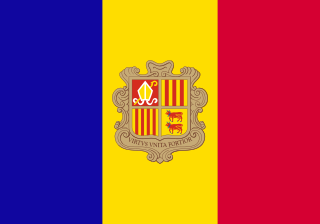
Sender Zehlendorf is a radio transmission facility which has been in service since 1936, when a short wave transmitter was built in Zehlendorf as part of the establishment of permanent radio services. This Zehlendorf site, which until the end of World War II was referred to as the Rehmate Radio Transmission Centre, had 26 different antennas.
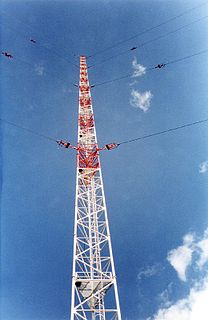
The Roumoules transmitter is the main broadcasting facility for longwave and mediumwave broadcasting of Radio Monte Carlo near Roumoules, France. The transmitters installed there are among the most powerful in the world and can be received well at nighttime throughout Europe.
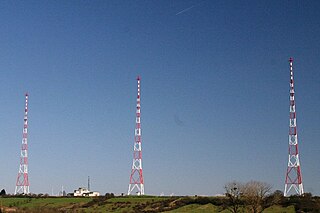
The Junglinster Longwave Transmitter is a longwave broadcasting facility used by RTL near Junglinster, Luxembourg, which went into service in 1932. Its aerial consists of three free-standing steel-framework towers, which are ground fed radiators. These towers formed a directional aerial for the frequency 234 kHz and until 1980 were 250 metres high. Since 1980 their height has been 215 metres.

The Mühlacker Broadcasting Transmission Facility is a radio transmission facility near Mühlacker, Germany, first put into service on November 21, 1930. It uses two guyed steel tube masts as aerials and one guyed steel framework mast, which are insulated against ground. It has two transmission aerials for shortwave and one free standing steel framework tower for directional radio services. The shortwave transmitter was shut off on October 19, 2004.

The Sendeanlage Bisamberg was an Austrian medium wave transmission facility built in 1933 and demolished on February 24, 2010.

The AM transmitter in Burg, near Magdeburg, Germany, is a huge facility for longwave and mediumwave broadcasting. Its most dominant constructions are a 324-metre guyed radio mast and two 210 metre guyed steel tube masts.

The Langenberg transmission tower is a broadcasting station that transmits MW, FM and TV signals. It is located in Langenberg, Velbert, Germany and has had a very turbulent history since its inauguration. The transmitter first went into service in 1927 with 60 kilowatts (kW) of power and a T-aerial hanging on two 100-metre freestanding steel-frame towers insulated against ground.

The Transmitter Hamburg-Billstedt is a broadcasting facility in Hamburg-Billstedt, established in 1934. It is owned and operated by the Norddeutscher Rundfunk public broadcasting service, but open to competitors, too.
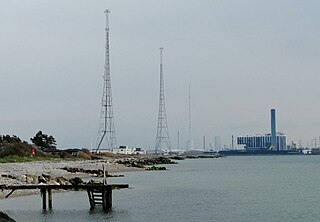
Kalundborg Radio is a major transmission facility for long- and mediumwave at the harbour of Kalundborg in Denmark.
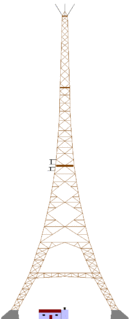
The Transmitter Ismaning was a large radio transmitting station near Ismaning, Bavaria, Germany. It was inaugurated in 1932. From 1932 to 1934 this transmitter used a T-antenna as transmitting antenna, which was spun between two 115-metre-high free-standing wooden lattice towers, which were 240 metres apart. As this antenna had an unfavourable vertical radiation pattern, which produced much skywave resulting in a too small fading-free reception area at night, in 1934 a new antenna was installed. Therefore, one of the towers was dismantled and rebuilt on a 39 metres high wooden lattice base. While this work took place, an L-Antenna was used, which was spun between the other tower and a small auxiliary wooden tower. It became defunct in 1977 and was destroyed in 1983.

The Rheinsender is a large medium-wave transmission facility near Wolfsheim, southwest of Mainz for the frequency 1017 kHz. The Rhine transmitter was established in 1950 and went on the air May 15, 1950. It belongs to SWR and transmitted until the middle of the 1990s with 600 kilowatts. In the last years the transmission power was reduced to 100 kilowatts.

The Heusweiler transmitter is a facility for medium wave broadcasting near Heusweiler, Germany, which originally went into service on 23 December 1935. On 19 June 1946 transmitter Heusweiler went in service again.

The Sottens Transmitter is the nationwide transmitter for French-speaking Switzerland. The transmitter is located at Sottens, Canton of Vaud, Switzerland. It is run on 765 kHz with a power of 600 kilowatts and is easily receivable during the night throughout the whole of Europe. Since 1989 the aerial used has been a centre-fed dipole fixed on the outside of a 188-metre-high grounded freestanding steel framework tower. Before 1989 a 190-metre high self-radiating, free standing steel framework tower was used as a transmission aerial. The Sottens transmitter most recently broadcast the Option Musique radio programme from Radio Suisse Romande, up until 5 December 2010.

The Mediumwave transmitter Lopik was a medium wave broadcasting facility near Lopik in the Netherlands. It was constructed in 1938 and closed down on 1 September 2015. Its last use was to transmit the Dutch language edition of Radio Maria on 675 kHz. The aerial consisted of a 196-metre guyed steel framework mast, which was insulated against ground.
The mediumwave transmitter Flevoland is a broadcasting facility for medium wave near Zeewolde in the province of Flevoland, Netherlands, situated at 5°25′ E and 52°23′ N. It has been used for broadcasting on 747 kHz and 1008 kHz with a nominal power of 400 kilowatts. As aerial two guyed steel framework masts with a height of 195 metres are used, which form an anti-fading aerial. These masts are grounded and carry a cage aerial, which is upperward the separation insulator, separating the masts in a height of 95 metres in two parts, connected toward the mast construction. The radiation diagram is directional, with a maximum gain of 4 dB in South-Eastern direction, to compensate for the variation in electrical admittance of terrain in the Netherlands.
The Wavre radio transmitter is a facility for mediumwave, shortwave, FM and TV broadcasting near Wavre in Belgium. For the mediumwave transmissions it uses a grounded 250-metre-high guyed mast. Furthermore, there is a backup mast for medium wave transmissions, which is 90 metres high. For shortwave broadcasting several directional antennas and a curtain antenna are used. The towers are two of the tallest structures in Belgium.
Transmitter Koszęcin is a facility for mediumwave and FM broadcasting near Koszecin, Poland. It was opened in 1977. It has two guyed masts: the first one is 110 metres high, is grounded, and carries antennas for FM broadcasting ; the second is 138m high. That second mast is insulated from ground and used for mediumwave transmission; broadcasting of the Radio Pahonia in Belarusian is planned on 1080 kHz with ERP 350 kW using this mast. The signal will cover the whole of Europe including the Ural Mountains. Earlier, the AM Mast was used for Polish Radio and used two Tesla transmitters 750 kW each in parallel. With the transmitted power of 1500 kW it was one of the most powerful mediumwave transmitters in the world.
The Domžale radio transmitter is a facility for medium wave broadcasting in Domžale, in Slovenia. The transmitter is fully transistorized. It could be received easily at a medium wave frequency of 918 kHz across the whole of Europe at night-time. It was the strongest radio transmitter of the Republic of Slovenia, broadcasting the first national radio channel.

The Vakarel Transmitter is a large broadcasting facility for long- and medium wave near Vakarel, Bulgaria. The Vakarel Transmitter was inaugurated in 1937. It has one directional antenna consisting of three guyed masts and another consisting of two masts.

The Nordkirchen transmitter is a medium-wave broadcasting facility of Deutsche Telekom near Nordkirchen in Northrhine-Westphalia. It was built in 1979 and 1980 after the 549 kHz frequency was again made available in that location.
